
General John Charles Meyer was an American World War II flying ace, and later the commander-in-chief of the Strategic Air Command (SAC) and director of the Joint Strategic Target Planning Staff at Offutt Air Force Base, Nebraska. SAC was the United States' major nuclear deterrent force with bombers, tankers and reconnaissance aircraft, and intercontinental ballistic missiles. The Joint Strategic Target Planning Staff coordinated the nation's nuclear war plans and developed the Single Integrated Operations Plan.

The 113th Operations Group is a flying group of the United States Air Force. It provides air sovereignty forces to defend District of Columbia and also provides fighter, airlift and support forces capable of local, national and global employment.

George Earl Preddy Jr. was a United States Army Air Forces officer during World War II and an American ace credited with 26.83 enemy air-to-air kills, ranking him as the top P-51 Mustang ace of World War II and eighth on the list of highest scoring American aces.

Royal Air Force Bodney or more simply RAF Bodney is a former Royal Air Force Station located 4.5 miles (7.2 km) west of Watton, Norfolk, England.

The 357th Fighter Group was an air combat unit of the United States Army Air Forces during the Second World War. The 357th operated P-51 Mustang aircraft as part of the U.S. Eighth Air Force and its members were known unofficially as the Yoxford Boys after the village of Yoxford near their base in the UK. Its victory totals in air-to-air combat are the most of any P-51 group in the Eighth Air Force and third among all groups fighting in Europe.

The 49th Fighter Group was a fighter aircraft unit of the Fifth Air Force that was located in the Asiatic-Pacific Theater during World War II.
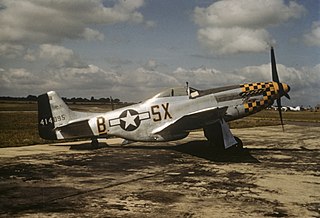
The 353rd Fighter Group, nicknamed the Slybird Group, was a fighter group of the United States Army Air Forces during World War II. The group was stationed in England and comprised the 350th, 351st, and 352nd Fighter Squadrons. It pioneered the P-47 dive-bombing and ground attack technique adopted by both Eighth and Ninth Air Forces. The group flew 447 combat missions and claimed 330 air and 414 ground aircraft destroyed. Group markings were black, yellow, black, yellow spinners, with a 48-inch black and yellow checker band around the cowling to the end of the exhaust stubs.
Zutendaal Air Base is a reserve Belgian Air Component base, located 4 mi (6.4 km) east-southeast of Genk (Limburg), approximately 50 mi (80 km) east-northeast of Brussels.
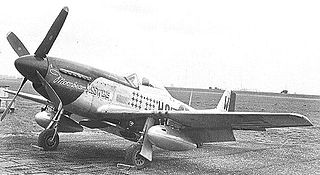
The 487th Fighter Squadron is an inactive United States Air Force unit. It activated during World War II and was assigned to the 352nd Fighter Group of VIII Fighter Command. After training in the United States, it deployed to the European Theater of Operations, where it earned two Distinguished Unit Citations and a French Croix de Guerre with Palm for its combat actions. Following V-E Day, it returned to the United States and was inactivated at the port of embarkation, Camp Kilmer, New Jersey, on 9 November 1945.

The 486th Fighter Squadron is an inactive United States Air Force unit. It activated during World War II and was assigned to the 352nd Fighter Group of VIII Fighter Command. After training in the United States, it deployed to the European Theater of Operations, where it earned a Distinguished Unit Citation and a French Croix de Guerre with Palm for its combat actions. Following V-E Day, it returned to the United States and was inactivated at the port of embarkation, Camp Kilmer, New Jersey, on 9 November 1945.

William Thomas Whisner Jr. was a career officer and pilot in the United States Air Force, retiring as a colonel with 30 years of military service. He was a fighter ace with Army Air Forces over Europe in World War II and a jet fighter ace with the Air Force in the Korean War.
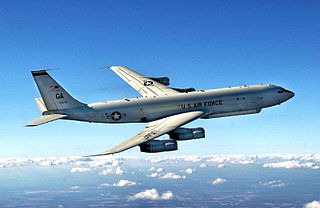
The 116th Operations Group is a Georgia Air National Guard unit assigned to the 116th Air Control Wing. The unit is stationed at Robins Air Force Base, Georgia. The 116th Group controls all operational Northrop Grumman E-8C Joint STARS aircraft of the 116th Air Control Wing. It was activated in 1992, when the Air Force implemented the Objective Wing organization, and was successively equipped with the McDonnell Douglas F-15 Eagle and the Rockwell B-1 Lancer before converting to the E-8C in 2002.

Joseph Lennard Mason was a colonel in the United States Air Force. He commanded the 352nd Fighter Group during World War II and was a fighter ace. He later commanded the 3595th Pilot Training Wing and the 49th Fighter-Bomber Wing during the Korean War.

Carl John Luksic was a United States Air Force lieutenant colonel. During World War II, he became a flying ace credited with 8.5 aerial victories, including five in one day for which he was awarded the Distinguished Service Cross. He himself was shot down and taken as a prisoner of war before his successful escape from captivity.
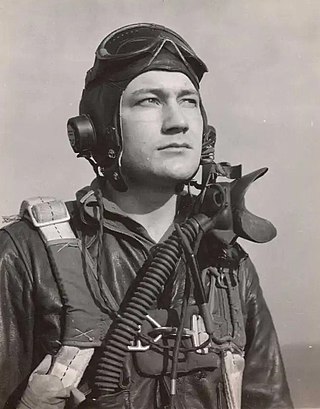
Raymond Henry Littge was an American flying ace in the 352nd Fighter Group during World War II, who was credited with 23.5 aerial victories.
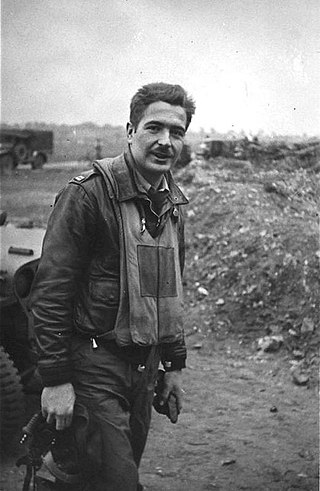
William Timothy Halton was a United States Army Air Force fighter ace in the 352nd Fighter Group who was credited with shooting down 10.5 aircraft during World War II. He was killed in action in 1952, during the Korean War.
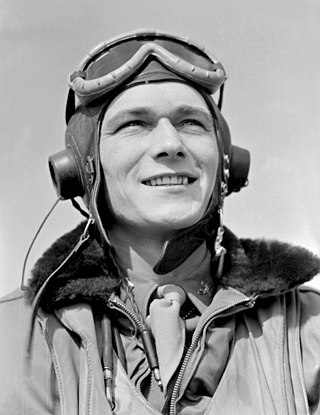
Donald Septimus Bryan was an American flying ace in World War II, who was credited with 13 aerial victories while serving with the 352d Fighter Group.

Edwin Lewis Heller was a United States Air Force lieutenant colonel and a flying ace, who was credited in destroying 5.5 enemy aircraft in aerial combat and 14 enemy aircraft on the ground during World War II. He also served in the Korean War, where he was credited in destroying 3.5 enemy aircraft before he was subsequently shot down and taken prisoner.
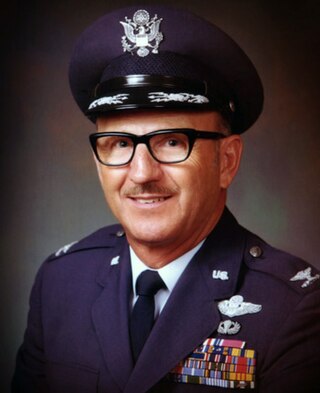
Virgil Kersh Meroney II was a United States Air Force colonel. During World War II, he became a flying ace credited with nine aerial victories while flying the P-47 Thunderbolt, making him the only P-47 ace in the 352nd Fighter Group. He himself was shot down and captured as a prisoner of war before his successful escape from captivity. He also flew missions during the Korean War and Vietnam War before he retired from the air force in 1970.
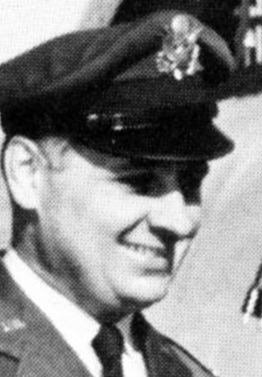
Glennon Timothy Moran was a brigadier general in the Missouri Air National Guard. During World War II, he was a flying ace credited with 13 aerial victories.






















